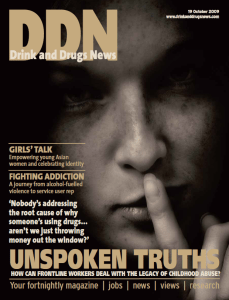When to call for more than a sticking plaster.
The statistics relating to frequency of sexual abuse are horrifying in their own right. But as our cover story highlights (page 6), while the legacy of abuse is widespread for many drug and alcohol clients, there is a total mismatch with the attention this difficult issue receives.
When we’ve written about the subject of childhood abuse before, we’ve been contacted by readers who wanted us to know how long it’s taken them to peel back the layers of drug and alcohol problems from the unhealed scars of abuse from their formative years. Considering how common this seems to be, how strange it is that so few agencies incorporate specific skills to help their staff recognise and address their clients’ past trauma. Everyone’s trimming their budgets, but this surely is the starkest example of a false economy. Treating the substance problem by whatever means does not negate the need to dig deeper and unearth the strands that have firmly rooted the client for years in drug, alcohol and mental health services.
The ‘sticking plaster’ approach highlighted by the Southmead Project does nothing to safeguard against relapse and promote any chance of long-term recovery. So why are we ignoring the massive influence of abuse throughout policy documents? Why are front-line workers reporting that their agencies can’t address this issue because they don’t get the dedicated funding for it?
Everyone’s noticing the recovery agenda at the moment (see letters, page 10) to the extent that it’s been officially recognised in national strategy for the drugs field. But why are the small but vital local support projects for victims of abuse struggling on with little or no funding? Working with clients at this level could offer vital new direction for victims of abuse and give them chance to experience the recovery agenda – and save miles of sticking plaster later on.
Read the magazine: PDF Version

